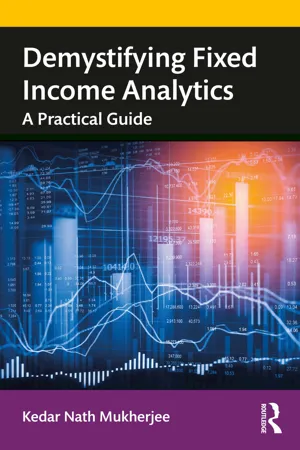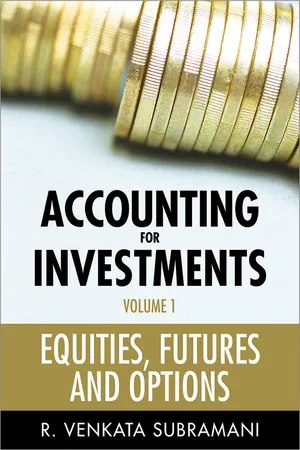Economics
Financial Derivatives
Financial derivatives are contracts whose value is derived from the performance of an underlying asset, such as stocks, bonds, commodities, or currencies. They are used for hedging against risk, speculating on price movements, and leveraging investment opportunities. Common types of derivatives include options, futures, forwards, and swaps, providing investors with a range of tools to manage their financial exposure.
Written by Perlego with AI-assistance
Related key terms
Related key terms
1 of 4
Related key terms
1 of 3
9 Key excerpts on "Financial Derivatives"
- Manolis G. Kavussanos, Dimitris A. Tsouknidis, Ilias D. Visvikis(Authors)
- 2021(Publication Date)
- Routledge(Publisher)
underlying commodity”. For instance, the value of a derivative contract on crude oil depends on the current and expected price of crude oil.The aim of this chapter is to provide an introduction to financial derivative products and to their use in the practice of business risk management and investment. It classifies the types of participants in derivatives markets according to their aims, the types of derivative products available, their specifications and provides a set of practical examples of their uses. The rest of the chapter is organised as follows: Section 3.2 summarises the major economic functions and benefits of Financial Derivatives, while Section 3.3 outlines the various risks associated with them. Section 3.4 presents the types of participants in derivatives markets, which range from hedgers to speculators and arbitrageurs. Then, Sections 3.5 to 3.7 present the basic derivative instruments, including futures/forwards, swaps and options, respectively, discussing their specifications, characteristics, trading issues, pricing and their use for hedging and speculation purposes. Section 3.8 presents the accounting treatment of derivative transactions. Finally, Section 3.9 concludes the chapter.3.2 The economic functions and benefits of Financial DerivativesOriginally, producers and consumers of commodities used derivative contracts to hedge (lock) commodity prices and in this way reduce their risk. The growth in derivative instruments has been attributed to their increasing use by governments, international corporations and major institutional and financial investors. They use derivatives in order to lower international funding costs, to provide better rates of exchange in international markets, to diversify their funding sources, to improve their risk management efficiency and to hedge price risks, amongst other functions. Fite and Pfleiderer (1995) show that Financial Derivatives allow traders to: (i) modify the risk profile of an investment portfolio, facilitating an efficient distribution of risks among risk bearers; (ii) enhance the expected return of a portfolio, depending on how efficiently risks can be shared among investors; (iii) reduce transactions costs associated with managing a portfolio; and (iv) circumvent regulatory obstacles.- eBook - ePub
Demystifying Fixed Income Analytics
A Practical Guide
- Kedar Nath Mukherjee(Author)
- 2020(Publication Date)
- Routledge India(Publisher)
8 Financial derivative contractsKey learning outcomesAt the end of this chapter, readers are expected to be familiar with:- Various concepts of derivatives markets and products: exchange traded vs. OTC market; forwards, futures, swaps, and options (call and put).
- Present status of Financial Derivatives markets worldwide and in India.
- Role of derivatives as a “useful financial innovation” and as a “weapon of mass destruction”.
- Estimation of payoffs to buyer and seller.
- Advantages/uses of derivatives contracts.
- Risks in and risk management of different types of derivative instruments.
A derivative may be defined as a financial instrument whose value depends on the value of another underlying asset. The International Monetary Fund (IMF) defines derivatives as:Financial Derivatives: meaning & types of contractsfinancial instruments that are linked to a specific financial instrument or indicator or commodity and through which specific financial risks can be traded in financial markets in their own right. The value of a financial derivative derives from the price of an underlying item such as an asset or index. Unlike debt securities, no principal is advanced to be repaid and no investment income accrues. - eBook - ePub
Financial Derivatives
A Blessing or a Curse?
- Simon Grima, Eleftherios I. Thalassinos, Rebecca E. Dalli Gonzi, Ioannis E. Thalassinos(Authors)
- 2020(Publication Date)
- Emerald Publishing Limited(Publisher)
2.2.2. DerivativesDerivatives, as explained in the first chapter, are financial contracts, whose ‘value depends on the values of one or more underlying assets or indexes’ (Adams & Runkle, 2000). However, Peter Hancock, head of Global Derivatives at J.P. Morgan, explains rather inaccurately, ‘derivatives … seem to have come to mean anything that lost money’ (Muehring, 1995, p. 21). Philippe Jorion in his book Big Bets Gone Bad (1995) noted that derivatives have been portrayed as ‘monster creatures’ to be feared and chained, indicating that this is no doubt due to the volume of trading in them and reflects a mystique of complexity and danger attached to them. Backstrand (1997), however, illustrated a more formal definition of a derivative depicting it as a ‘financial instrument, or contract, between two parties that derives its value from some other underlying asset or underlying reference price, interest rate, or index’.Philippe Jorion, in the same book noted above (1995), notes that there are well over hundred varieties of derivatives, many with difficult names. He notes some of these as caps, diffs, floors, swaptions, inverse floaters, knock-outs, step-ups and binaries. He indicates that the development in IT, modern microelectronics and software was the tools that have allowed mathematicians and even physicists create some highly sophisticated financial instruments. They are also hidden in mortgages and in debt instruments called structured notes. However, in their purest (plain vanilla) form as we shall see below, derivatives include forward contracts, futures, swaps and options.Derivatives allow firms and government entities ‘to identify, isolate, and manage the market risks in financial instruments and commodities, separately’. This is the reason why firms are increasingly relying on derivatives activities as ‘a direct source of revenue through market-making functions, position taking, and risk arbitrage’ (Basel Committee on Banking Supervision (BCBS), 1994). These financial instruments can be further categorised into exchange traded, with an actual physical location where all trades occur and over the counter (OTC), which are traded over a decentralised network of Banks or Financial Institutions. All futures and many options contracts have been standardised and are traded on established exchanges (Romano, 1996), whereas forwards, swaps and some options are custom-tailored contracts (Goldman, 1995). - P. C. G. Vassiliou(Author)
- 2013(Publication Date)
- Wiley-ISTE(Publisher)
Chapter 2An Introduction to Financial Instruments and Derivatives
2.1. Introduction
The construction of stochastic models for the pricing of financial instruments, especially in continuous time, often involves very sophisticated stochastic and mathematical concepts. However, the economic insights needed to do so are, in fact, simple and transparent, if one takes the time and energy to clarify them in a rigorous and simple way, doing away with the traditional jargon that one usually comes across. In this chapter, we will try to briefly do so since our emphasis in the book is on the stochastic models involved and not institutional considerations. For the latter there are many excellent books such as Hull (2008), Cox and Rubinstein (1985) and Jarrow and Turnbull (2000).A derivative security is a financial contract whose value is derived from the value of an underlying asset, hence the name. The underlying asset could be any raw material of importance to an economy such as wheat, petrol, salt, metals, or any industrial product. Also, the underlying asset all too often is a financial instrument such as a bond, foreign currency, or even another derivative security. Derivative securities may be grouped into the following broad headings: options, forward and futures and swaps . We will not attempt to survey the range of derivative securities now traded in the financial markets, but we will instead concentrate on the more basic options in attempt to create a basic knowledge which the reader will be able to expand conveniently.The basic players in the everyday exchange of financial instruments and assets are: (a) individuals , whose everyday need for consumption and investment is one of the driving forces for the evolution of the entire financial world; (b) corporations who own or have a need of, raw materials, land, and machines and manage manufacturing to meet demand. To raise funds for their growth, corporations all too often issue bonds and stocks. In this respect, corporate management is constrained and directed toward meeting the interests of shareholders and bondholders; (c) intermediaries , such as banks, investment companies, insurance companies, stock exchanges, option and future exchanges, etc.; (d) financial markets- eBook - ePub
Value Making in International Economic Law and Regulation
Alternative Possibilities
- Donatella Alessandrini(Author)
- 2016(Publication Date)
- Routledge(Publisher)
Derivatives have acquired the centre stage in the course of the financial crisis that started in the US and spread quickly to other (mainly Western) financialised economies. Despite the different interpretations of the underlying factors (McNally, 2009; Gowan, 2009; Bellamy Foster and Magdoff, 2009), the consensus was that the unregulated proliferation of Financial Derivatives has been one of its most important triggers, particularly since the ‘miscalculation’ of their risks emerged fully in 2008, sending shock waves through the international financial system first and the global economy later. The fact that the notional amount outstanding for over-the-counter (OTC) derivatives, that is derivatives not traded on formal exchanges, was estimated by the Bank for International Settlements (BIS) at US$615 trillion (BIS, 2010) and led many to wonder exactly what kind of financial instruments derivatives are, what kind of value they express and what type of relationship they have with the so-called real economy.Addressing these questions, however, is not an easy task. The standard definition of derivatives in finance textbooks is that of contracts whose value is derived from the value of an underlying asset, an asset being a commodity or a financial asset, such as interest rates and exchange rates (see eg Goss, 1976; Gordon, 1986). However, to talk about derivatives in an undifferentiated manner is problematic since they refer to different things as well as different values. For instance, futures and options, which are the simplest forms of derivatives, are different contracts. Generally speaking, futures are contracts where two parties commit to buy or sell a certain asset at a future date and at an agreed price, whereas options are contracts that confer the right to buy or sell a particular asset at a certain date and at a certain price. Not only are they different things, they also refer to different values. With futures we are talking about the value the asset is supposed to have at a future date, whereas with options at issue is the value of the right to buy or sell the underlying asset at a certain price. It is sufficient to think about the various other types of derivatives that are today in circulation – forward, swaps, credit default swaps, collaterised debt obligations, etc – to appreciate that any comprehensive definition is unsatisfactory. - eBook - ePub
- Indranarain Ramlall(Author)
- 2018(Publication Date)
- Emerald Publishing Limited(Publisher)
Chapter 4
Derivatives and Financial Stability
4.1. Derivatives
Derivatives constitute sophisticated financial instruments which are used by traders in the world for various purposes. The three main types of traders in derivatives are speculators, arbitrageurs and hedgers. Speculators are traders which undertake risky transactions in view of generating large profits. The risk involved is usually high, and in extreme cases, speculators can even kill the markets. Arbitrageurs represent traders who pocket riskless profits by availing themselves of short-term inefficiencies in the markets. Finally, hedgers are those traders who buy derivatives in order to reduce risk.There are four major types of derivatives in the world, namely futures, forwards, swaps and options. Among these four categories, options tend to be imbued with complex structures, alternatively known as asymmetric payoff profiles. Futures and forwards share similar linear payoff profiles. Swaps mainly represent the exchange of cash flows, whether in the same or different currencies, mostly in view of mitigating interest rate risk or currency risk.However, it is of paramount significance to note that derivatives mishaps can be very costly. As pointed out by Hull (2010), big losses in derivatives occurred for both financial and non-financial institutions in the world, as shown in the Boxes 4.1 and 4.2 - eBook - ePub
- R. Venkata Subramani(Author)
- 2011(Publication Date)
- Wiley(Publisher)
A derivative is a financial security, such as an option or futures contract, whose value depends on the performance of an underlying security or asset. Futures contracts, forward contracts, options, and swaps are the most common types of derivatives. Derivatives are generally used by institutional investors to increase overall portfolio return or to hedge portfolio risk. A derivative is a financial instrument that does not constitute ownership, but a promise to convey ownership.All derivatives are based on some underlying cash product. For example, the underlying cash products could be any of the following:- Equity shares . These include equity shares listed in the stock exchanges, indexes based on the equity market, and so on.
- Commodities . These include grain, wheat, pepper, coffee, cotton, crude oil, and so on.
- Spot foreign exchange . This is buying and selling of foreign currency at the spot rates that are quoted by the interbanks through the Society for Worldwide Interbank Financial Telecommunication (SWIFT).
- Bonds . Bonds come in many varieties, such as Eurobonds, domestic bonds, fixed interest or floating rate notes, and so on. Bonds are medium- to long-term negotiable debt securities issued by governments, government agencies, federal or state bodies, the World Bank, or companies. These bonds may be freely traded without reference to the issuer of the security if they are negotiable.
- Short-term money market negotiable debt securities
- Dongsheng Lu(Author)
- 2016(Publication Date)
- Palgrave Macmillan(Publisher)
I INTRODUCTION TO DERIVATIVES TRADINGPassage contains an image 1 Overview of Derivatives Trading
Financial Derivatives are widely used in economic activities by a variety of market participants for the purposes of hedging, investment and speculations, among other things. A derivative is a legal contract agreed between two or more parties, which defines the contingent claims or cash flows “derived” from the underlying price to be paid by the parties in the future. Derivatives can be traded on the exchanges or over the counter (OTC). OTC derivatives and their valuations are the focus of this book.1.1 The participants in the derivatives market and their interactionsA simple schematic view of the derivatives market participants is shown in Figure 1.1 . In the left box is a dealer with different functional departments; the right box shows a number of dealers trading with each other in the broker market (in light gray), and competing in the customer market (in dark gray). At the bottom of the chart, the regulators interact with all market participants, create and enforce rules and regulations, so that the market operates smoothly.In this chapter, we will look at the market participants, their functions in the market, the market mechanisms, and the various aspects involved in the derivatives trading and market dynamics. 1.1.1 Derivative providers vs. derivative usersWithin the derivatives market, there are participants who are “experts” and “providers” of the derivatives products and liquidity. These are what are loosely defined as “dealers”. These dealers are expected to be the derivative experts, with expertise in the pricing, trading and risk management of derivative products. They determine the derivatives prices traded in the market through market trading mechanisms. They provide liquidity and two-way prices for products through market making activities and customer trading mechanisms. While there is no general definition of “dealer”, within Dodd–Frank rules, “swap dealer” is defined as a swap market maker, with swap dealing activities exceeding the de minimis notional threshold of $8 billion over a 12-month period. This definition is, however, for regulatory purposes.- eBook - ePub
Financial Derivatives
Pricing and Risk Management
- Rob Quail, James A. Overdahl, Robert W. Kolb, James A. Overdahl(Authors)
- 2009(Publication Date)
- Wiley(Publisher)
Greg Kuserk is the deputy director for market surveillance at the Commodity Futures Trading Commission. He earned a BBA in business administration from the University of Notre Dame in 1980 and an MS in agricultural economics from the University of Delaware in 1983. Mr. Kuserk has been at the CFTC since 1987 and has served in several capacities as a research economist and policy advisor. He has provided technical assistance in the area of futures market regulation to exchanges and government regulators in Romania and Ethiopia and has authored a number of articles on the design and function of futures markets.Passage contains an image CHAPTER 4
The Social Functions of Financial DerivativesCHRISTOPHER L. CULPSenior Advisor, Compass Lexecon, and Adjunct Professor of Finance, The University of Chicago Booth School of BusinessDespite the long-standing concerns about their social costs, derivatives are among the oldest and most prevalent financial instruments in the global capital markets, having been used successfully by financial institutions, nonfinancial corporations, asset managers, and government-sponsored enterprises in their commercial, financial, and risk management activities. Many of the later chapters in this book review in more detail the various ways that firms can use derivatives constructively. Subsequent chapters also address some of the controversies surrounding derivatives, including the role they have played (if any) in recent financial crises and corporate scandals.In this chapter, however, we explore a higher-level and more general topic than how derivatives have (or have not) impacted the fortunes of particular enterprises. Specifically, we consider here how the use of derivatives by some firms can benefit individuals and firms apart from those directly participating in derivatives activity.1 These “social functions” of derivatives include:2• Facilitating risk transfer. • Serving as arenas for price discovery. • Promoting the efficient allocation of resources to their most highly valued uses over time.
Index pages curate the most relevant extracts from our library of academic textbooks. They’ve been created using an in-house natural language model (NLM), each adding context and meaning to key research topics.
Explore more topic indexes
Explore more topic indexes
1 of 6
Explore more topic indexes
1 of 4








